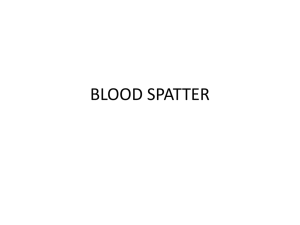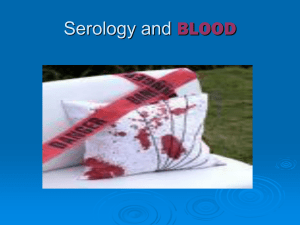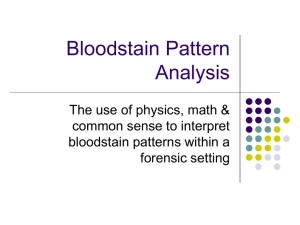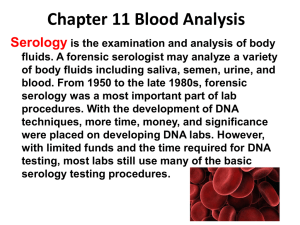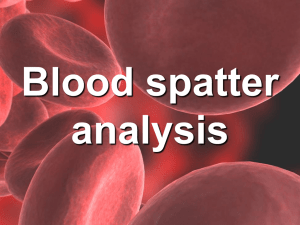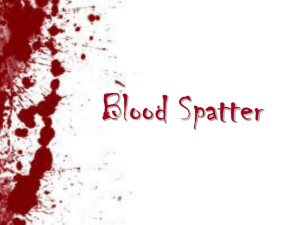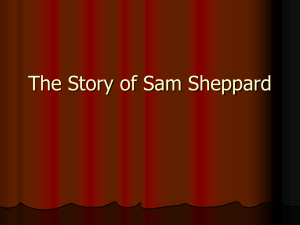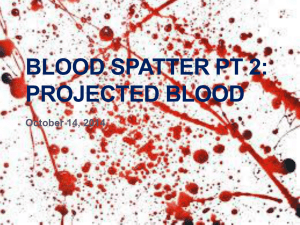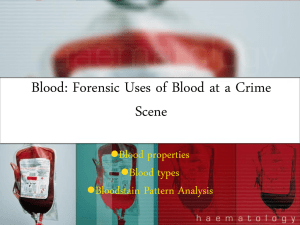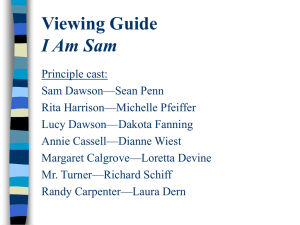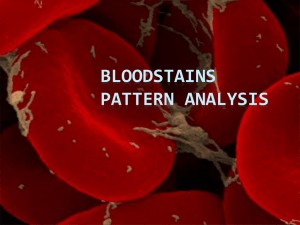Blood Spatter - Uplift Education
advertisement
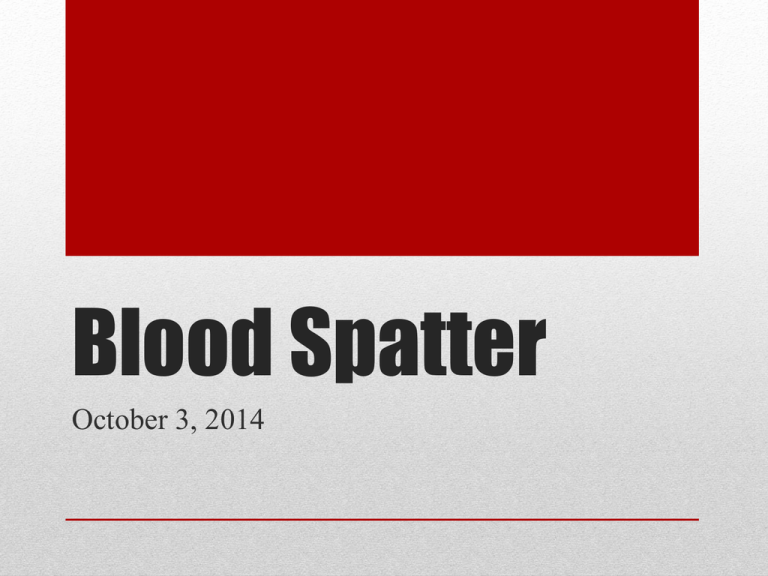
Blood Spatter October 3, 2014 Early on the morning of July 4, 1954 police received a call from Dr. Sam Sheppard. He reported that his wife had been killed the night before. Sam & Marilyn Sheppard Sam Sheppard Case Sam’s Story • He went to sleep on the couch • Heard his wife shout “Sam”and awoke • Found a person standing by his wife’s bed. They struggled, Sam was hit on the back of the neck, and lost consciousness. • When he awoke, he found his wife covered in blood. He took her pulse and found that she was dead. Marilyn, partially undressed and covered in blood. Sam Sheppard Case Sam’s Story • When he regained consciousness, the intruder was gone. • He checked on sleeping son next door – he was fine. • Went downstairs and saw intruder leaving. • Chased and battled the “tall bushyhaired” intruder on the beach, was choked, and again lost consciousness • Awoke in the morning, wet & missing his shirt and watch. Sheppard (?) with a neck brace Sam Sheppard Case Police investigation • Marilyn was found in bed, with her clothes partially removed and covered in blood • More than 20 blows to her head • Appearance of staged robbery Crime scene sketch of Sheppard home Sam Sheppard Case Police investigation • Marilyn was found in bed, with her clothes partially removed and covered in blood • More than 20 blows to her head • Appearance of staged robbery Quote from Marilyn’s friend’s husband, who was allowed to view the scene: "Oh my God. It looks like someone stood in the middle of the room with a great big can of red paint and a brush and flicked it all around. This wasn't a couple of blows. Oh no. Whoever did it, they had to be out of their mind.“ Sam Sheppard Case 1954 Trial • Police quickly concluded the Sheppard killed his wife and (perhaps) did a somewhat sloppy job examining the evidence • The case garnered a lot of publicity, and the press was very hostile to Sheppard • The trial had “carnival-like atmosphere” and the defense offered little evidence other than Sam’s story and injury. • Convicted and sentenced to life in prison. Sam Sheppard Case Supreme Court Verdict • In 1966 the Supreme Court overturned Sheppard’s conviction, arguing that he did not receive a fair trial due to the publicity surrounding the trial Sam Sheppard Case 1966 Retrial • Respected criminalist Dr. Paul Kirk re-examined the blood spatter evidence and testified for the defense • Blood spatter consistent with left-handed killer (Sam Sheppard is right-handed) • Blood on Sheppard’s watch and clothing was transferred blood not back spatter • Sheppard was pronounced not guilty. The End … or is it? Sam Sheppard Case 2000 Civil Trial • In 2000, Sam Sheppard’s son sued the county for wrongful imprisonment. • The jury sided with the county, and 6 of 8 jurors said they believed Sheppard to be the murderer. So … is he guilty?? You decide! Sam Sheppard Case Blood spatter – the patterns left on a crime scene by blood – can be used to help reconstruct the events of a crime. By observing spatter, you can determine • The direction of travel • The angle of impact • The position origin • The droplet’s speed What can you learn from blood spatter? Passive blood • Blood drops that form by the force of gravity, alone. • Example: Blood dripping or oozing from a wound or a weapon A murder throws a bloody knife into the bushes, leaving blood spatter on the Projected blood grass. something Is this passive • Blood drops that form when otherblood than projected gravity applies a force or to the blood.blood. Why? • Example: Arterial pressure, blunt force trauma, gunshot, etc. Classifying Spatter Talk with a partner, and take a guess … How will each of these factors affect passive blood spatter patterns? 1. Distance of dropping 2. Angle of impact 3. Surface of impact Passive Blood Spatter Patterns Distance of Dropping • Passive blood falls due to gravity • Accelerates until reaching terminal velocity • Higher the fall faster the velocity of impact (up to a point) • Terminal velocity is ~25 ft per second, occurs with fall of ~5ft • Faster velocity / Higher fall = larger diameter of drop. Which drop fell from the greatest height? The drop on the upper left. Passive Blood Spatter Patterns E B D A C F Match each stain from the height with the heights at which they were dropped. Assume the same amount of blood fell with each drop Heights: 1.5 ft, 2 ft, 3 ft, 5 ft, 7 ft, 10 ft Passive Blood Spatter Patterns E B D A C F Match each stain from the height with the heights at which they were dropped. Assume the same amount of blood fell with each drop Heights: 1.5 ft (E), 2 ft (C), 3 ft (B), 5 ft (?), 7 ft (?), 10 ft (?) Why don’t A, D, and F vary much in size? Passive Blood Spatter Patterns E B D A C F Match each stain from the height with the heights at which they were dropped. Assume the same amount of blood fell with each drop Heights: 1.5 ft (E), 2 ft (C), 3 ft (B), 5 ft (?), 7 ft (?), 10 ft (?) Why don’t A, D, and F vary much in size? Blood reaches terminal velocity at about ~5 ft. Passive Blood Spatter Patterns Angle of Impact • Drops that hit at a 90O angle (i.e. straight down) form an even circle. • Drops that hit at other angles form an elongated oval • The longer the oval, the shallower the angle of impact Passive Blood Spatter Patterns Angle of Impact The angle of impact can be calculated using the formula: Angle of impact = arcsine ( 𝑤𝑖𝑑𝑡ℎ ) 𝑙𝑒𝑛𝑔𝑡ℎ 3 cm 5 cm Angle of impact = arcsine (3/5) = 37 degrees Passive Blood Spatter Patterns Angle of Impact Angle of impact = arcsine You do: Find the angles. 𝑤𝑖𝑑𝑡ℎ ( ) 𝑙𝑒𝑛𝑔𝑡ℎ Which drop had a greater angle of impact? The one on the left What does it mean to have a greater angle of impact? The greater 2 cm 30 degrees 4 cm 3 cm 49 degrees 4 cm the angle, the more perpendicular (straight down) the drop lands. Passive Blood Spatter Patterns Surface of Impact Drops falling onto smooth, non-porous surfaces have smooth edges (they don’t splash). Drops falling onto rough surfaces produce spiny / irregular stains and possibly satellite spatter. Spatter on tile Satellite spatter are the small drops that surround a central drop. They form when the blood splashes after hitting the surface. Spatter on wood Passive Blood Spatter Patterns Think, Pair, & Share. What can you tell me about this spatter? • What were our objectives today? How did we meet them? • What was our learner profile trait and how did we use it? • How does what we did today address our unit objective? Closure • Draw some blood spatter patterns in the below. Write a short paragraph describing the spatter. Use at least 5 of the following vocab words in your paragraph: passive blood, projected blood, angle of impact, velocity of impact, terminal velocity, surface of impact, satellite spatter. Exit Ticket
